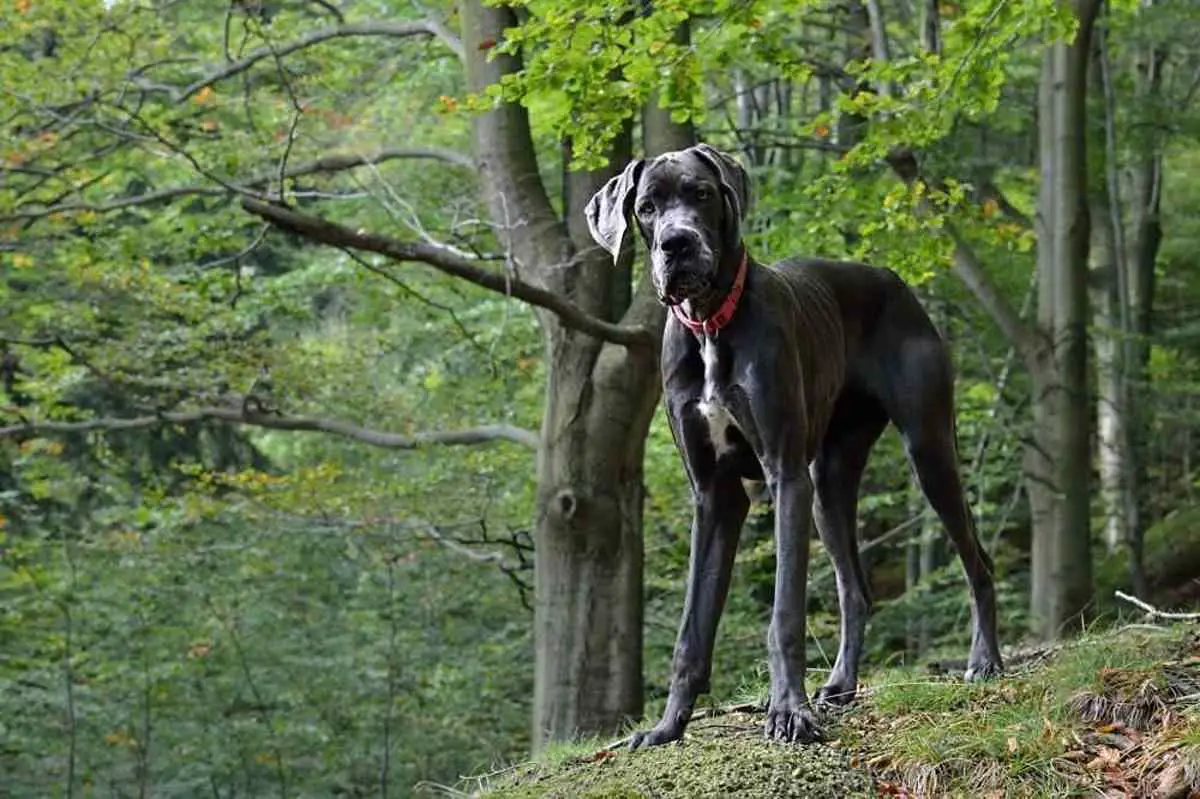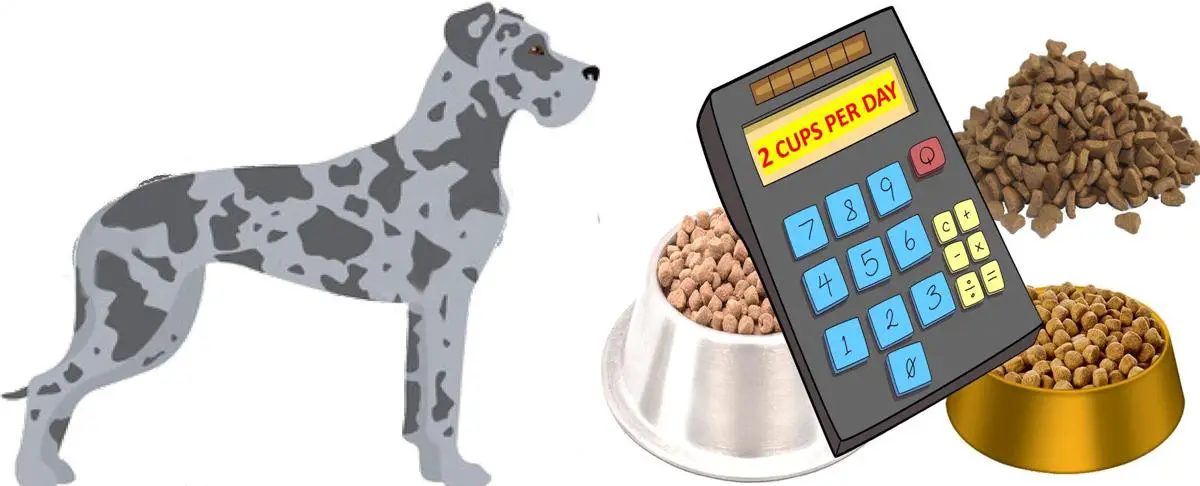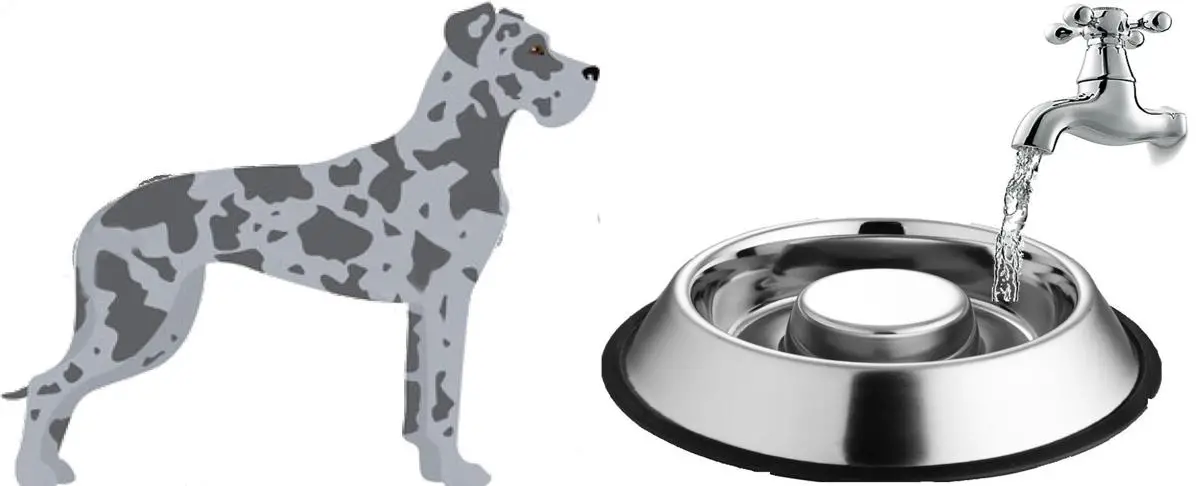Quick Links: Table of Contents
- Great Dane Breed Overview
- History of the Great Dane Breed. Where Great Danes came from
- What the Great Dane Looks Like
- How Much is the Great Dane Puppy?
- Best Great Dane Breeders
- Adopting or Rescuing the Great Dane
- Great Dane Growth
- What Colors do Great Danes Have?
- The Temperament of the Great Dane
- How Long Great Danes Live
- Great Dane Litter Size
- How Fast Great Danes Can Run
- Good Names for Great Danes
- How Intelligent are Great Danes?
- How Popular are Great Danes with New Dog Owners?
- Health Problems in Great Danes and How to Prevent Them
- How to Take Care of Great Dane
- Dog Breeds That Are Similar to Great Danes
- Other Things to Know About Great Danes
Great Dane Breed Overview
The Great Dane is a giant-sized dog.
The adult Great Dane stands 26 to 34 inches tall at the shoulder.
The Great Dane belongs to the Working Dogs group.
Dogs in the Working Dogs group, like the Great Dane, were developed to assist humans in some capacity – including pulling sleds and carts, guarding flocks, guarding homes, and protecting their families.
Breeds in the Working Group are known for their imposing stature, strength, intelligence, and fearless.
Because of their size and strength, working dogs require a structured home life and firm, fair, consistent training by someone who can provide leadership without resorting to anger or physical force.
The fact that the Great Dane belongs to the Working Dogs group is one of the reasons why Great Danes have the personality and temperament that they have.
The temperament of the Great Dane is generally described as:
- Confident
- Devoted
- Friendly
- Gentle
- Loving
- Reserved
History of the Great Dane Breed. Where Great Danes came from
These massive dogs are thought to have originated around 3000 B.
C.
, when drawings of similar-looking dogs were discovered in Babylonian Temples built around 2000 B.
C.
Similar dogs may have existed in Tibet, according to written accounts discovered in Chinese literature around 1121 B.
C.
The Assyrians are thought to have spread the Great Dane breed around the world by trading their dogs to the Romans and Greeks, who would then breed them with other dogs of different breeds.
They are thought to be descended from the Irish Wolfhound, English Mastiff, and Irish Greyhound.
The first of these were called Boar Hounds because they were bred to hunt them.
In the 16th century, their name was changed to English Dogges.
Later that century, however, it was common for German nobles to keep their large and handsome dogs in their homes, leading to their name being changed once more to Kammerhunde, which translates to Chamber Dogs.
In the 1700s, a French naturalist was traveling in Denmark when he discovered a different version of the Boar Hound that was slimmer and resembled the Greyhound.
He gave these dogs the name Grand Danois, which was later changed to Great Danish Dog.
Danish Mastiffs were the larger dogs of this breed.
The German breeders are frequently credited with refining these dogs, and a meeting of breeders and judges was held in 1880.
.
What the Great Dane Looks Like
These large canines are sleek and athletic, with muscular bodies and massively sized long, narrow heads.
Their necks are long, graceful, and set high as well.
Except for females, who may have bodies that are slightly longer than their height, their bodies tend to be as long as they are tall.
They have deep muzzles, black, blue/black, or black spotted noses, and deep, dark eyes that are medium in size.
The Great Dane`s ears are set high and medium in size, and can be cropped and stood erect or left natural, folding forward and hanging near the cheek.
Round feet with dark toenails will result from the perfectly straight front legs.
The thick tails will eventually thin out to a point and will also be carried high.
Their coats are short and thick, and they come in a variety of colors.
Examples include Fawn, black, blue, brindle, merle, chocolate, and harlequin.
.
How Much is the Great Dane Puppy?
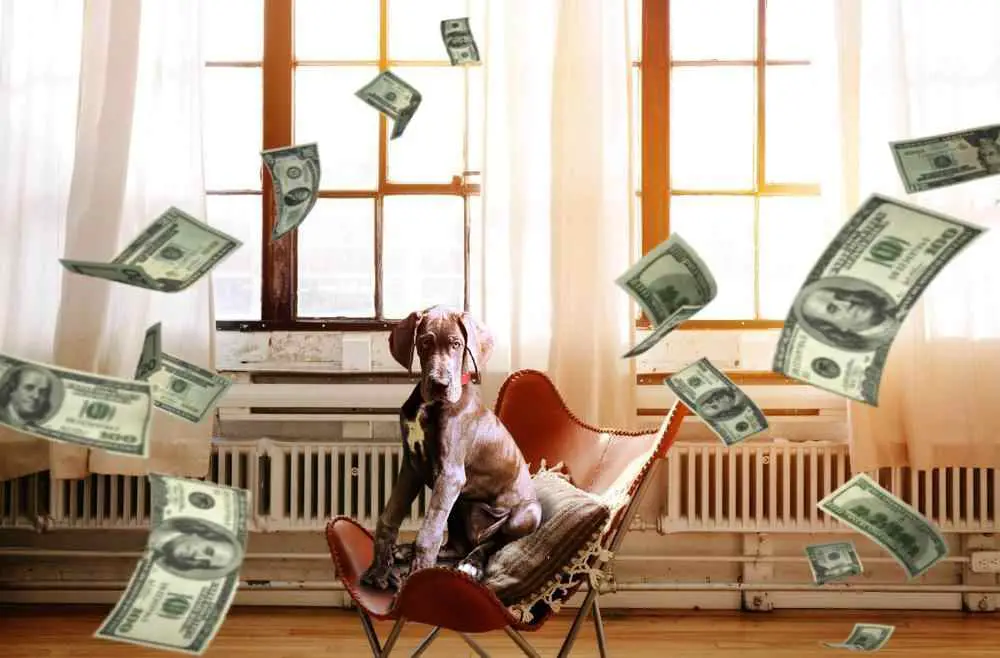
The average price of a Great Dane puppy is $1560. The price of a Great Dane puppy ranges from $1000 to $2000.
A lot of factors determine the price of the Great Dane. These factors include what health records the Great Dane puppy has, the lineage of the Great Dane puppy, the US state the breeder is located in, etc.
To estimate how much you can expect to pay for a puppy Great Dane based on the many factors that determine the price of the Great Dane puppy, check out our calculator that lets you estimate how much you should expect to pay for the Great Dane puppy based on what you want in the puppy.
When looking to buy a puppy, look at buying a puppy only from well-established breeders that breed puppies primarily for the love of the Great Dane breed, and secondarily for profit. Do not buy a puppy from a puppy mill. Puppy mills mass-produce puppies in bad living conditions for maximum profit.
You may also consider adopting instead of buying a puppy. Adoption costs are very low compared to the price of a puppy.
Best Great Dane Breeders
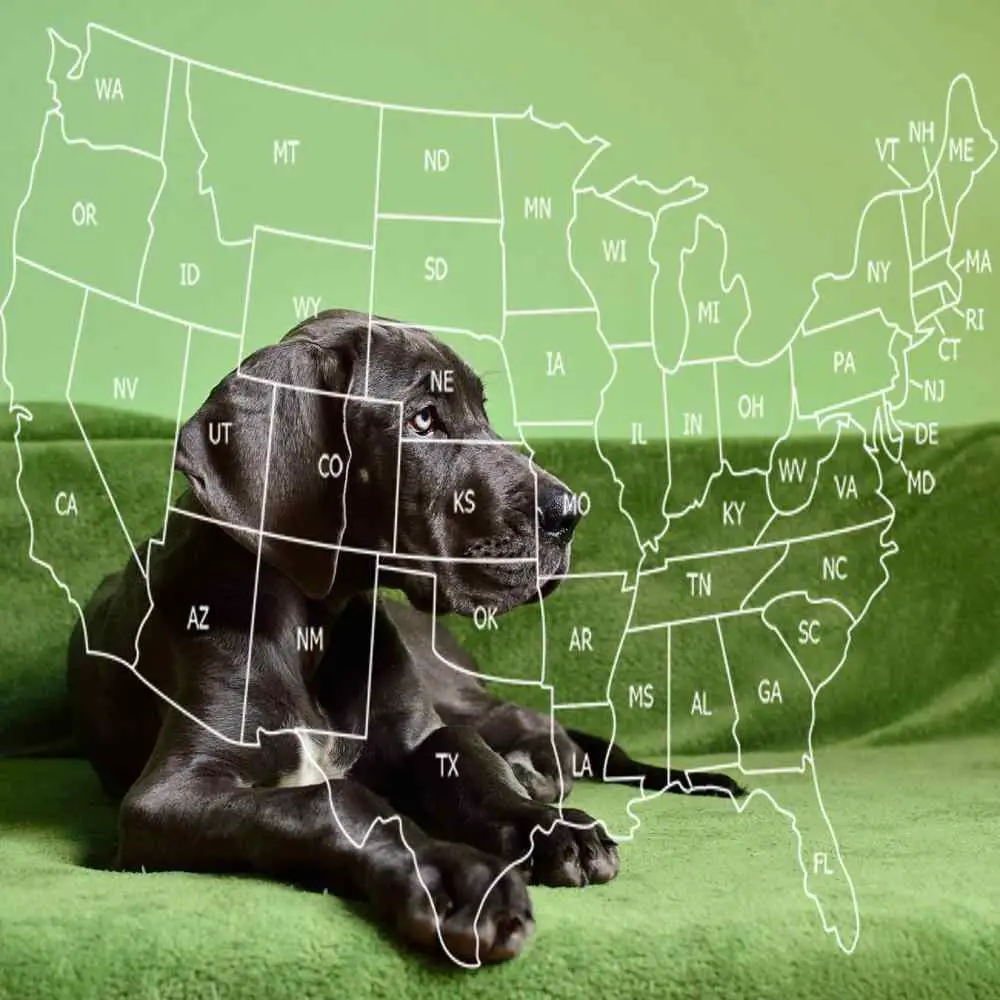
We have researched reputable Great Dane breeders that you can buy a puppy.
Go to this page for our complete list of reputable Great Dane breeders in various states in the United States.
On this page, you will see how much these breeders sell their puppies for, and how many puppies they have available.
A few of these breeders are listed below.
LC Blue Great Danes
Puppy Price: Check with breeder
Patientdanes
Puppy Price: $1250 -$ 1750
Gandolphs Legend V Yukon
Puppy Price: $2500
Newton`s AKC Great Dane`s
Puppy Price: Check with breeder
La.greatdanes
Puppy Price: Check with breeder
Adopting or Rescuing the Great Dane
You may consider adopting a dog instead of buying a puppy. Many dogs, Great Danes included, are currently available for adoption in your local dog shelters.
These helpless but adorable dogs are waiting in dog shelters hoping that someday someone will rescue them. Dog adoption costs are lesser than the cost of a new puppy. Dog adoption costs are usually around $300 or even less.
In addition to your local dog shelter, another good place to find dogs that are available for adoption is petfinder.com.
Below is an adorable Male Great Dane named Bentley that is currently available for adoption on Petfinder.com. You can find other lovely Great Danes like Bentley on pefinder.com.
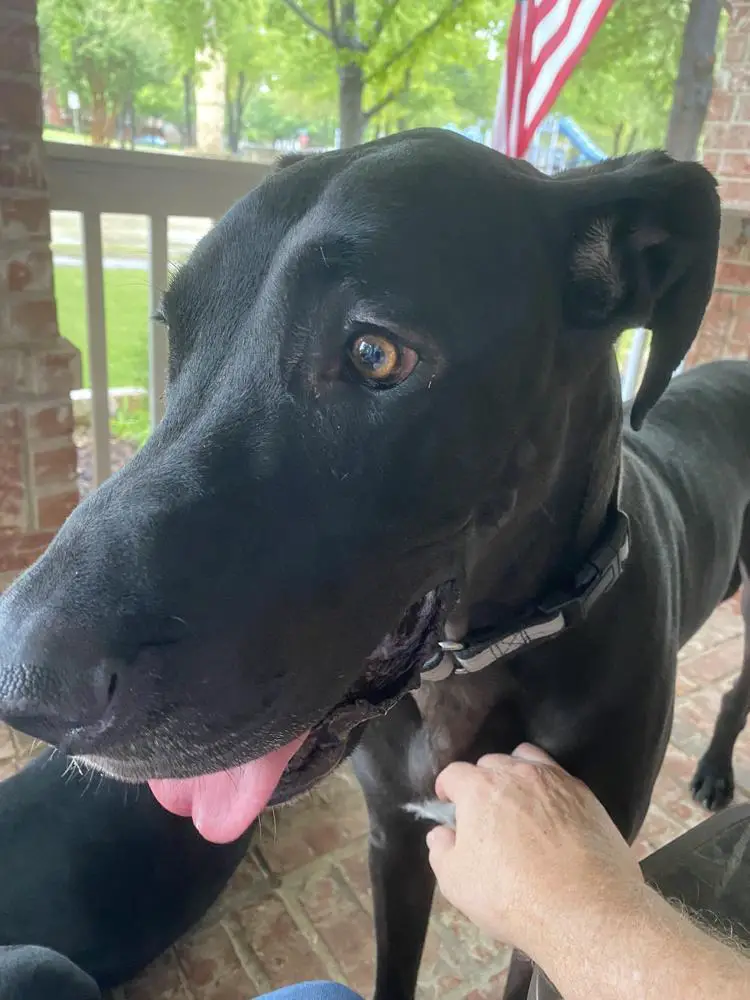
Otis is the name of another Great Dane (Male) on petfinder.com that is looking for a new forever home.
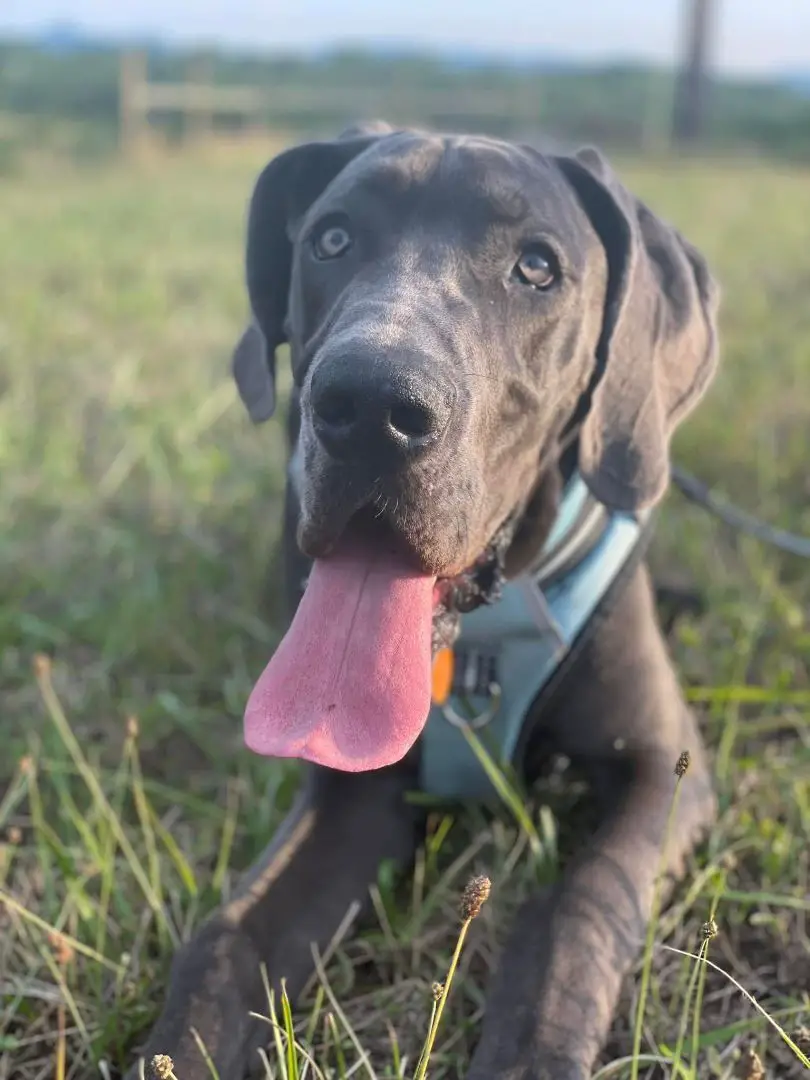
You can find more Great Danes that are available for adoption on petfinder.
Great Dane Growth
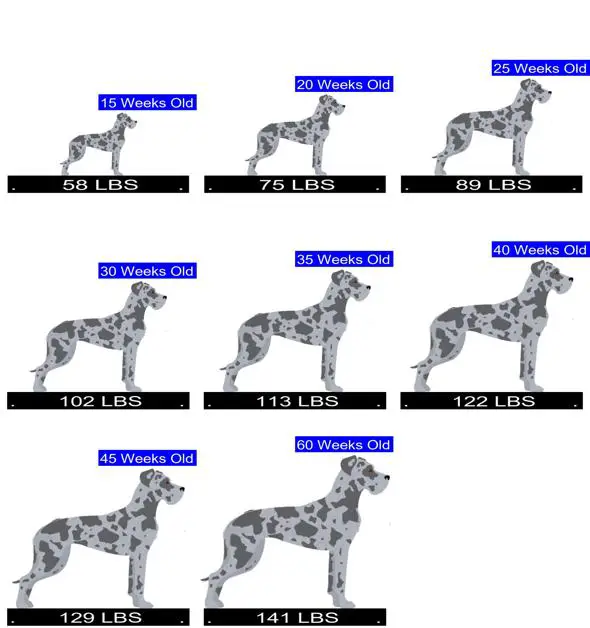
New Great Dane owners need to know about the growth of their Great Danes. This will help them plan their living spaces accordingly.
Also, knowing the typical growth pattern of the Great Dane will help new owners catch the abnormal growth of their Great Dane early.
See our calculator for predicting how big your Great Dane puppy will get. You will also learn about the typical weight of the Great Dane at different ages and how to catch abnormal growth in your Great Dane
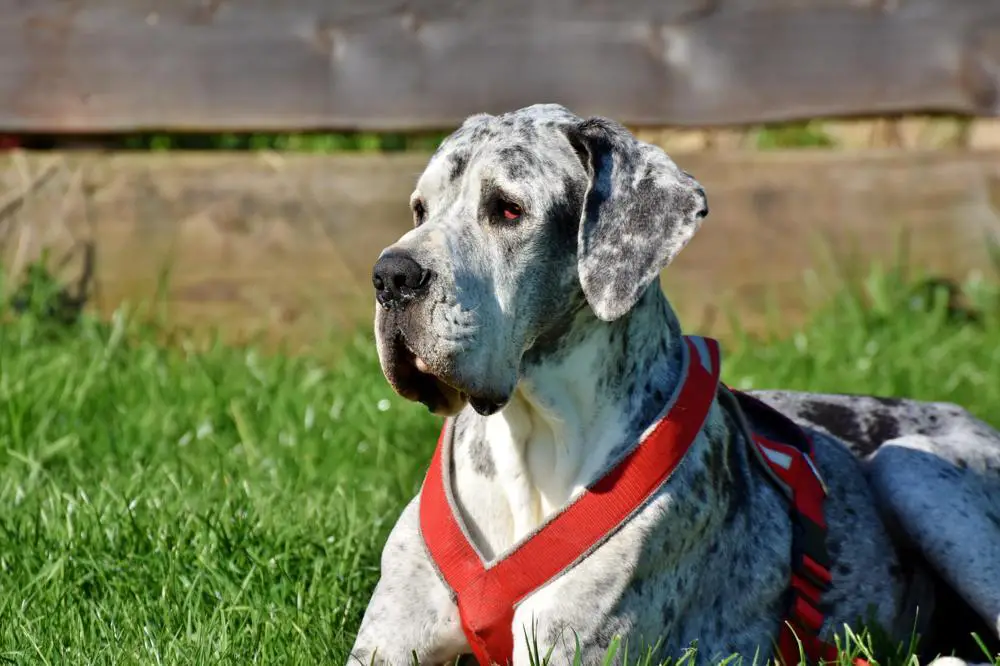
What Colors do Great Danes Have?
Great Danes come in the following beautiful primary colors:
- Black
- Harlequin
- Merle (Blue)
- Yellow / Tan / Blond / Fawn
- Brown / Chocolate
- White / Cream
- Brindle
- Tricolor (Brown, Black, & White)
- Merle (Red)
- Bicolor
- Gray / Blue / Silver
Great Danes come in the following lovely secondary colors in addition to their primary colors:
- White / Cream
- Brown / Chocolate
- Black
- Gray / Blue / Silver
- Golden
- Merle (Blue)
- Harlequin
- Brindle
- Yellow / Tan / Blond / Fawn
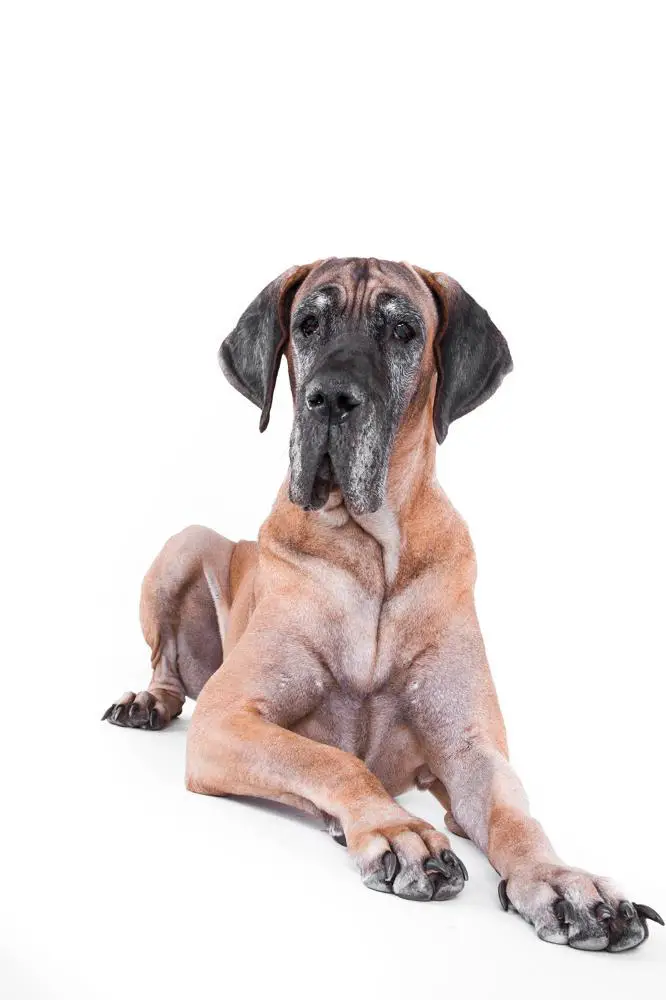
The Temperament of the Great Dane
The temperament of the Great Dane based can be summarized as in the table below.
The table shows the scores of the Great Dane for 13 important dog behavioral factors.
We obtained these scores by analyzing raw data from the C-BARQ dog personality survey tool. The higher the score of a dog for a factor, the worse the temperament of the dog regarding that factor.
The C-BARQ tool was developed by researchers from the University of Pennsylvania, and it is a scientific tool that is used worldwide for reliably measuring the temperament of dog breeds.
See our complete analysis of the temperament of the Great Dane here.
| Factor | Score |
|---|---|
| Owner Directed Aggression | 6.1 percent |
| Attachment Attention Seeking | 52.6 percent |
| Dog Directed Aggression | 39.8 percent |
| Energy Level | 36.5 percent |
| Stranger Directed Aggression | 34.8 percent |
| Separation Related Behavior | 34.6 percent |
| Stranger Directed Fear | 34.4 percent |
| Excitability | 33.0 percent |
| Stubbornness | 29.1 percent |
| Nonsocial Fear | 28.4 percent |
| Prey Drive | 28.0 percent |
| Touch Sensitivity | 26.5 percent |
| Dog Directed Fear | 24.9 percent |
| Dog Rivalry | 21.3 percent |
How Long Great Danes Live
The lifespan of the Great Dane is typically from 7 to 10 years.
Moreover, a few years back, veterinarian researchers performed a scientific study to determine the lifespan of the Great Dane. In this study, the scientists collected data on how long 171 pet Great Danes lived.
From the study, it was found that Great Danes have an average lifespan of 6.5 years. Furthermore, the study found that it is not uncommon for Great Danes to live as long as 14.1 years.
Note that you need to put in some effort if you want your Great Dane to live long.
Great Danes live long if they eat well, drink well, exercise well, and visit the veterinarian regularly.
There are also dog supplements that you can give your Great Dane to improve your Great Dane`s quality of their life.
Click here to learn more about how to make your Great Dane live long.
Great Dane Litter Size
Researchers from the Norwegian School of Veterinary Science did a study where they counted the numbers of puppies in 29 different Great Dane birth litters.
From this study, the researchers found that the average number of puppies that Great Danes can have is 7 puppies. Also, the Great Dane can have as few as 1 puppies per litter and as many as 13 puppies per litter.
The number of puppies that the Great Dane will have depends on factors such as the age of the Great Dane, the method of pregnancy, etc.
Click here to see our calculator for predicting how many puppies your Great Dane will have and how the litter size of the Great Dane compares to the litter size of other dog breeds.
How Fast Great Danes Can Run

How fast a dog breed can run is a good measure of how athletic the dog breed is.
The American Kennel Club (AKC) regularly conducts dog running competitions. The AKC records the running speed of competing dogs in these competitions. These competitions are open to all dog breeds.
Based on our analysis of the speeds of 278 different Great Danes, the average speed of the Great Dane is 22.9 mph (36.9 kmph).
The fastest speed on AKC record that the Great Dane ran in a race is 35.33 mph (56.9 kmph) and the minimum speed on record in a race for a Great Dane is 7.0 mph (11.3 kmph).
Click here to see how the speed of the Great Dane compares to the speed of other dogs and other mammals such as cats, horses, humans, etc.
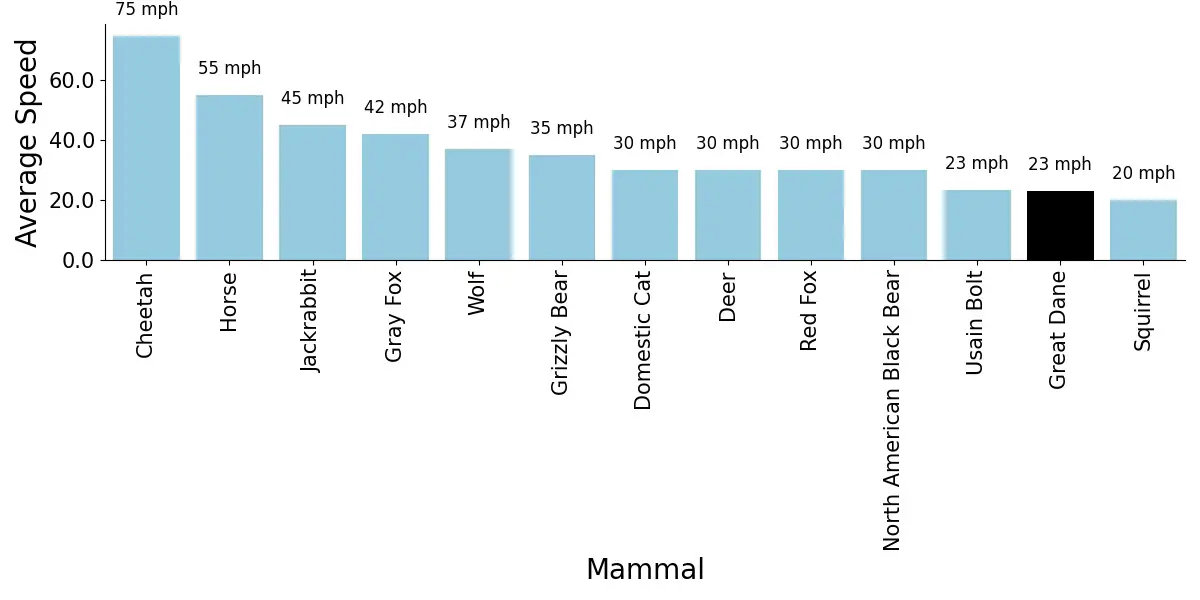
Good Names for Great Danes
Here are some really good names that are typical for the Great Dane ranked by popularity:
- Duke
- Moose
- Scooby
- Diesel
- Charlie
- Marmaduke
- Zeus
- Jack
- Goliath
- Big
How Intelligent are Great Danes?
| Great Dane | |
|---|---|
| Intelligence Rank | 48 out of 130 dog breeds |
| Trainability | Tend To Learn New Commands After 25 To 40 Repetitions |
According to Prof. Stanley Coren, a Canadian psychology professor/dog trainer, the total intelligence that a dog demonstrates is the addition of three types of intelligence. These intelligence types are:
- Instinctive Intelligence: This is the natural intelligence that comes from instinct. For example, dog breeds that have been historically bred to be guard dogs will have a high `guarding` intelligence compared to dogs that were not bred for guarding.
- Adaptive Intelligence (learning and problem-solving ability): This indicates what a dog can learn to do for himself or herself. Adaptive intelligence is specific to each dog, and not breed specific. You can improve your dog`s adaptive intelligence by investing time to train your dog.
- Working/Obedience Intelligence: This type of intelligence is breed-specific. Certain dog breeds tend to have higher working/obedience intelligence than some other breeds. This intelligence is the closest to what we might call school-learning ability and it is based upon what the dog can learn to do when instructed by humans. This type of intelligence can be measured for each dog breed and compared to that of other dog breeds.
Professor Stanley Coren measured and ranked the working intelligence of about 130 different dog breeds.
Prof. Coren found that the Great Dane has an obedience intelligence rank of 48 out of 130 dog breeds. Thus, Prof. Coren put Great Danes in the `Average Working/Obedience Intelligence Dogs` category.
This means that Great Danes tend to learn new commands after 25 to 40 repetitions.
However, we should mention that a dog should not be judged based on its intelligence alone. There are other important factors you need to consider when deciding on which dog breed to get. These other factors include sociability, adorability, and compatibility of the dog breed with your lifestyle.
See the intelligence ranking of some other dog breeds below:
| Breed | Intelligence Rank |
|---|---|
| Border Collie | 1 |
| Golden Retriever | 4 |
| Doberman Pinscher | 5 |
| Shetland Sheepdog | 6 |
| Papillon | 8 |
| Rottweiler | 9 |
| English Springer Spaniel | 13 |
| Weimaraner | 21 |
| Belgian Malinois | 22 |
| Pomeranian | 23 |
| Irish Water Spaniel | 24 |
| Vizsla | 25 |
| Cairn Terrier | 35 |
| Affenpinscher | 37 |
| American Foxhound | 46 |
| Rhodesian Ridgeback | 52 |
| Norfolk Terrier | 56 |
| Saint Bernard | 65 |
| Pekingese | 73 |
| American Bulldog | 77 |
How Popular are Great Danes with New Dog Owners?
Every year, the American Kennel Club (AKC) publishes information on how popular a dog breed is in that particular year. The AKC gets the popularity information of a breed from how many dogs of that breed the owners register with the AKC every year. The AKC collects this data for about 200 dog breeds.
The graph below shows the popularity trend of the Great Dane.
The popularity of the Great Dane averaged over the years is Number 15 out of about 200 dog breeds.
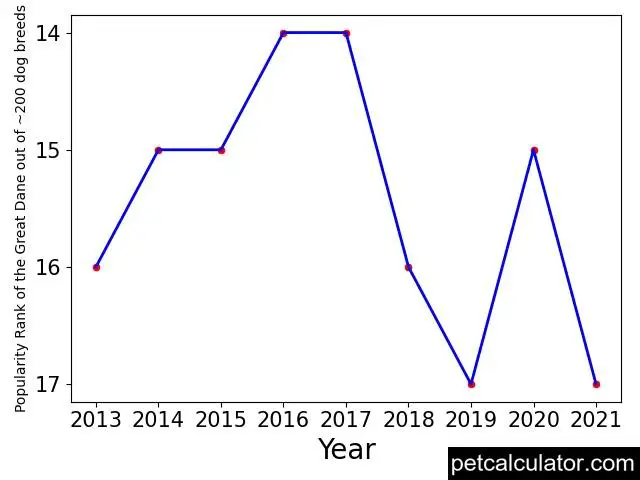
Do not get a dog breed just because it is a popular dog breed. And do not reject a dog breed just because it is an unpopular breed.
Health Problems in Great Danes and How to Prevent Them
Every dog breed has its own set of health problems that it tends to develop. There is nothing like a perfect dog breed.
The Great Dane is prone to certain genetic health conditions. The Orthopedic Foundation for Animals (OFA) is an organization that keeps track of genetic health problems in dog breeds.
From the extensive records that the OFA keeps, the OFA knows what health problems each dog breed is naturally prone to develop.
Hence, the OFA recommends which health screening breeders should perform on a dog breed to make sure that the breeders won`t breed `defective` dog parents that can pass down defective genes to their puppy offspring.
If you want a Great Dane puppy that will grow up to be healthy, make sure that your Great Dane breeder screens your puppy or your puppy`s parents for the health problems that the OFA recommends for your puppy`s breed. This will increase the chances that your puppy is free from genetic defects.
The following are the health tests that Orthopedic Foundation for Animals (OFA) recommends that breeders should screen Great Danes for:
You can find out more about OFA`s recommended tests for Great Danes here.
How to Take Care of Great Dane
To take good care of your Great Dane, you need to make sure that you groom your Great Dane regularly.
Secondly, you need to find a veterinarian in your area that will routinely check the health status of your Great Dane regularly, and give you appropriate recommendations on your Great Dane`s preventative care.
Thirdly, you need to commit some time to exercise your Great Dane daily. Regular exercise helps improve the health and quality of life of your Great Dane.
Also, you need to feed your Great Dane high-quality dog food, and the food should be of the right amount to prevent your Great Dane from getting overweight or underweight.
See our recommendations on what to feed the Great Dane and how much food to feed the Great Dane at different life stages.
Finally, you need to make sure that your Great Dane has access to clean water all the time. See our recommendations on how much water your Great Dane needs to drink at different ages.
Dog Breeds That Are Similar to Great Danes
If you have not made up your mind on which dog breed to get, you may also want to consider some other dogs similar to the Great Dane.
We crunched the numbers and found that the following dog breeds that have similar behavior and temperament as the Great Dane:
- Flat-Coated Retriever (72 percent match with Great Dane). Learn more about the Flat-Coated Retriever here.
- Labrador Retriever (72 percent match with Great Dane). Learn more about the Labrador Retriever here.
- Shiloh Shepherd (70 percent match with Great Dane). Learn more about the Shiloh Shepherd here.
Other Things to Know About Great Danes
Here are some of the very important characteristics of the Great Dane that you need to know about the Great Dane breed:
